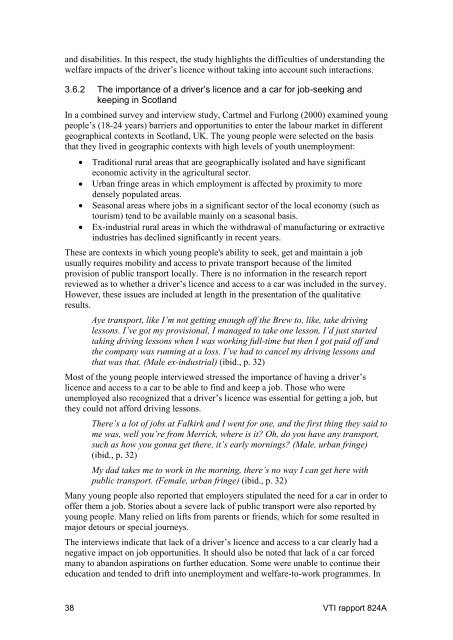utvecklingen-av-korkortsinnehav-bland-unga-mojliga-forklaringar-konsekvenser-och-trender
utvecklingen-av-korkortsinnehav-bland-unga-mojliga-forklaringar-konsekvenser-och-trender
utvecklingen-av-korkortsinnehav-bland-unga-mojliga-forklaringar-konsekvenser-och-trender
Create successful ePaper yourself
Turn your PDF publications into a flip-book with our unique Google optimized e-Paper software.
and disabilities. In this respect, the study highlights the difficulties of understanding thewelfare impacts of the driver’s licence without taking into account such interactions.3.6.2 The importance of a driver’s licence and a car for job-seeking andkeeping in ScotlandIn a combined survey and interview study, Cartmel and Furlong (2000) examined youngpeople’s (18-24 years) barriers and opportunities to enter the labour market in differentgeographical contexts in Scotland, UK. The young people were selected on the basisthat they lived in geographic contexts with high levels of youth unemployment:Traditional rural areas that are geographically isolated and h<strong>av</strong>e significanteconomic activity in the agricultural sector.Urban fringe areas in which employment is affected by proximity to moredensely populated areas.Seasonal areas where jobs in a significant sector of the local economy (such astourism) tend to be <strong>av</strong>ailable mainly on a seasonal basis.Ex-industrial rural areas in which the withdrawal of manufacturing or extractiveindustries has declined significantly in recent years.These are contexts in which young people's ability to seek, get and maintain a jobusually requires mobility and access to private transport because of the limitedprovision of public transport locally. There is no information in the research reportreviewed as to whether a driver’s licence and access to a car was included in the survey.However, these issues are included at length in the presentation of the qualitativeresults.Aye transport, like I’m not getting enough off the Brew to, like, take drivinglessons. I’ve got my provisional, I managed to take one lesson, I’d just startedtaking driving lessons when I was working full-time but then I got paid off andthe company was running at a loss. I’ve had to cancel my driving lessons andthat was that. (Male ex-industrial) (ibid., p. 32)Most of the young people interviewed stressed the importance of h<strong>av</strong>ing a driver’slicence and access to a car to be able to find and keep a job. Those who wereunemployed also recognized that a driver’s licence was essential for getting a job, butthey could not afford driving lessons.There’s a lot of jobs at Falkirk and I went for one, and the first thing they said tome was, well you’re from Merrick, where is it? Oh, do you h<strong>av</strong>e any transport,such as how you gonna get there, it’s early mornings? (Male, urban fringe)(ibid., p. 32)My dad takes me to work in the morning, there’s no way I can get here withpublic transport. (Female, urban fringe) (ibid., p. 32)Many young people also reported that employers stipulated the need for a car in order tooffer them a job. Stories about a severe lack of public transport were also reported byyoung people. Many relied on lifts from parents or friends, which for some resulted inmajor detours or special journeys.The interviews indicate that lack of a driver’s licence and access to a car clearly had anegative impact on job opportunities. It should also be noted that lack of a car forcedmany to abandon aspirations on further education. Some were unable to continue theireducation and tended to drift into unemployment and welfare-to-work programmes. In38 VTI rapport 824A


